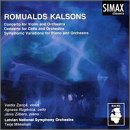| All Artists: Kalsons, Zarins, Rugevica, Zilbers, Mikkelsen Title: Concerto for Violin & Orchestra Members Wishing: 0 Total Copies: 0 Label: Simax Release Date: 7/25/2000 Album Type: Import Genre: Classical Styles: Forms & Genres, Concertos, Symphonies Number of Discs: 1 SwapaCD Credits: 1 UPC: 675754234324 |
Search - Kalsons, Zarins, Rugevica :: Concerto for Violin & Orchestra
 | Kalsons, Zarins, Rugevica Concerto for Violin & Orchestra Genre: Classical
|
Larger Image |
CD Details |
CD ReviewsAnyone who likes Bartok... Thomas F. Bertonneau | Oswego, NY United States | 03/24/2001 (4 out of 5 stars) "Vogue Records operated on Westwood Boulevard just outside the UCLA campus from the mid-1950s sometime until about 1977 or 78, when a Tower Records opened up across the street and spelled its doom. Joe Cooper, who managed the classical side of Vogue's fare, used to job in piles of Melodiya LPs from the Soviet Union. I bought one, on his advice, along about 1972 or 73. It contained two works by a Latvian composer, Romualds Kalsons (born 1936): a Symphony* and a "Music for Strings." Luckily, this particular LP was a decent pressing.** The Symphony's movements bore neo-classical titles like "Prelude and Fugue," "Canto," and "Toccata." The music clearly derived from Hindemith, from Bartók, and from Shostakovich. It was charged with moto-perpetuo rhythms and employed a piquant counterpoint involving very high and very low registers simultaneously. (Imagine double-basses and trombones chugging forward in half-notes while piccolo and glockenspiel skirl and chime respectively in syncopated eighths.) When the Symphony reached its final bars, one felt that one had witnessed a great, well-oiled, but slightly archaic machine being put through its complicated paces. "I grok it," I later told Joe. (I had been reading Heinlein's "Stranger in a Strange Land.") Alas, my LP collection is a decade or more liquidated; so is the Soviet Union, with Latvia again an independent nation. And just now the name Kalsons resurfaces on CD. Simax gives us the Concertos for Cello (1970) and for Violin (1978) and the Symphonic Variations (1978), also a concerted work, for piano and orchestra. Terje Mikkelsen (a Norseman) leads the Latvian National Symphony Orchestra. Like the two Shostakovich entries in the genre, Kalson's Violin Concerto comprises four, rather than the usual three, movements. It imitates Shostakovich by removing the violins from the orchestra to generate the maximum of contrast between soloist and ensemble. The longest movement, the Third, is a nocturnal "Andante con Moto." Its theme is said to be "an ancient Latvian wedding-song" symbolizing peace and prosperity. The Cello Concerto comes from close in time, I would imagine, to the Symphony on that long-lost Melodiya LP and communicates in the same dense and powerful language. In the Finale, a lovely passacaglia opens the way to a vigorous fugue making use of folk-motifs. (Of Baltic origin, one supposes.) The Symphonic Variations for Piano and Orchestra is slghtly more aggressive (though by no means unpleasantly so) than its two companion-works on the disc. The Latvian National Symphony Orchestra plays with liveliness and enthusiasm. This is engaging, even convincing, music. It will appeal to collectors whose taste runs to Bartók, Shostakovich, and their compositorial progeny. Recommended. [*Kalsons' first three symphonies (according to his website) date from 1964, 1968, and 1972. The symphony that I remember is, I believe, the 1964 composition; but I am not absolutely certain. **A good many of those Soviet platters, on low-quality vinyl, proved unlistenable through their pops, ticks, and frustrating smears of distorted sound. I, for one, have never missed the long-playing vinyl disc.]"
|

 Track Listings (8) - Disc #1
Track Listings (8) - Disc #1